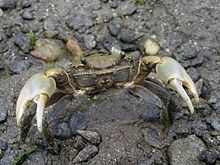| Helice tridens | |
|---|---|

| |
|
Scientific classification
| |
| Domain: | Eukaryota |
| Kingdom: | Animalia |
| Phylum: | Arthropoda |
| Class: | Malacostraca |
| Order: | Decapoda |
| Suborder: | Pleocyemata |
| Infraorder: | Brachyura |
| Family: | Varunidae |
| Genus: | Helice |
| Species: | H. tridens
|
| Binomial name | |
| Helice tridens | |
| Synonyms [2] | |
| |
Helice tridens is a species of crab which lives on mudflats around the coasts of Japan and the Korean Peninsula. [3]
Ecology
It is semi-terrestrial, returning to the sea to spawn. [4] The species appears to be adversely affected by the presence of raccoons (Procyon lotor), an invasive predator. [4] H. tridens has a salinity requirement which lies between those of two other estuarine crabs in Japan, Helicana japonica and Chiromantes dehaani. [5]
Smaller individuals shelter in burrows in reed marshes, apparently in order to avoid cannibalism; this may also be the reason for the migration of larger individuals to brackish water lagoons in summer, when the crabs exceed their carrying capacity. [6]
Taxonomy
Helice tridens was first described by Wilhem de Haan in an 1835 volume of Fauna Japonica, as Ocypode tridens. [7] The former subspecies H. t. wuana and H. t. sheni are now recognised as a separate species, Helicana wuana. [2]
References
- ^ "Helice tridens". Crabs of Japan. Retrieved January 31, 2009.
- ^ a b P. K. L. Ng, D. Guinot & P. J. F. Davie (2008). "Systema Brachyurorum: Part I. An annotated checklist of extant Brachyuran crabs of the world" (PDF). Raffles Bulletin of Zoology. 17: 1–286. Archived from the original (PDF) on 2011-06-06.
- ^ Hsi-Te Shih & Hiroshi Suzuki (2008). "Taxonomy, phylogeny, and biogeography of the endemic mudflat crab Helice/Chasmagnathus complex (Crustacea: Brachyura: Varunidae) from East Asia" ( PDF). Zoological Studies. 47 (1): 114–125.
- ^ a b Hisayo Hayama, Masato Kaneda & Mayuh Tabata (2006). "Rapid range expansion of the feral raccoon (Procyon lotor) in Kanagawa Prefecture, Japan, and its impact on native organisms". In F. Koike; M. N. Clout; M. Kawamichi; M. De Poorter & K. Iwatsuki (eds.). Assessment and Control of Biological Invasion Risks (PDF). Shoukadoh Book Sellers, Kyoto, Japan and IUCN, Gland, Switzerland. pp. 196–199. Archived from the original (PDF) on 2011-07-22. Retrieved 2009-01-31.
- ^ Bambang Irawan & Akihiro Kijima (1994). "Difference of salinity requirements among the three estuarine crab species, Chiromantes dehaani, Helice tridens and H. japonica (Brachyura: Grapsidae)" (PDF). Tohoku Journal of Agricultural Research. 44 (1–4). Archived from the original (PDF) on 2012-06-02. Retrieved 2009-01-31.
- ^ Yasushi Kurihara, Katsuhiro Sekimoto & Masahide Miyata (1988). "Wandering behaviour of the mud-crab Helice tridens related to evasion of cannibalism" (PDF). Marine Ecology Progress Series. 49: 41–50. doi: 10.3354/meps049041.
- ^ Wilhem de Haan (1835). "Ocypode (Helice) tridens sp. nov.". In Philipp Franz von Siebold (ed.). Fauna Japonica. p. 57.
External links
-
 Media related to
Helice tridens at Wikimedia Commons
Media related to
Helice tridens at Wikimedia Commons